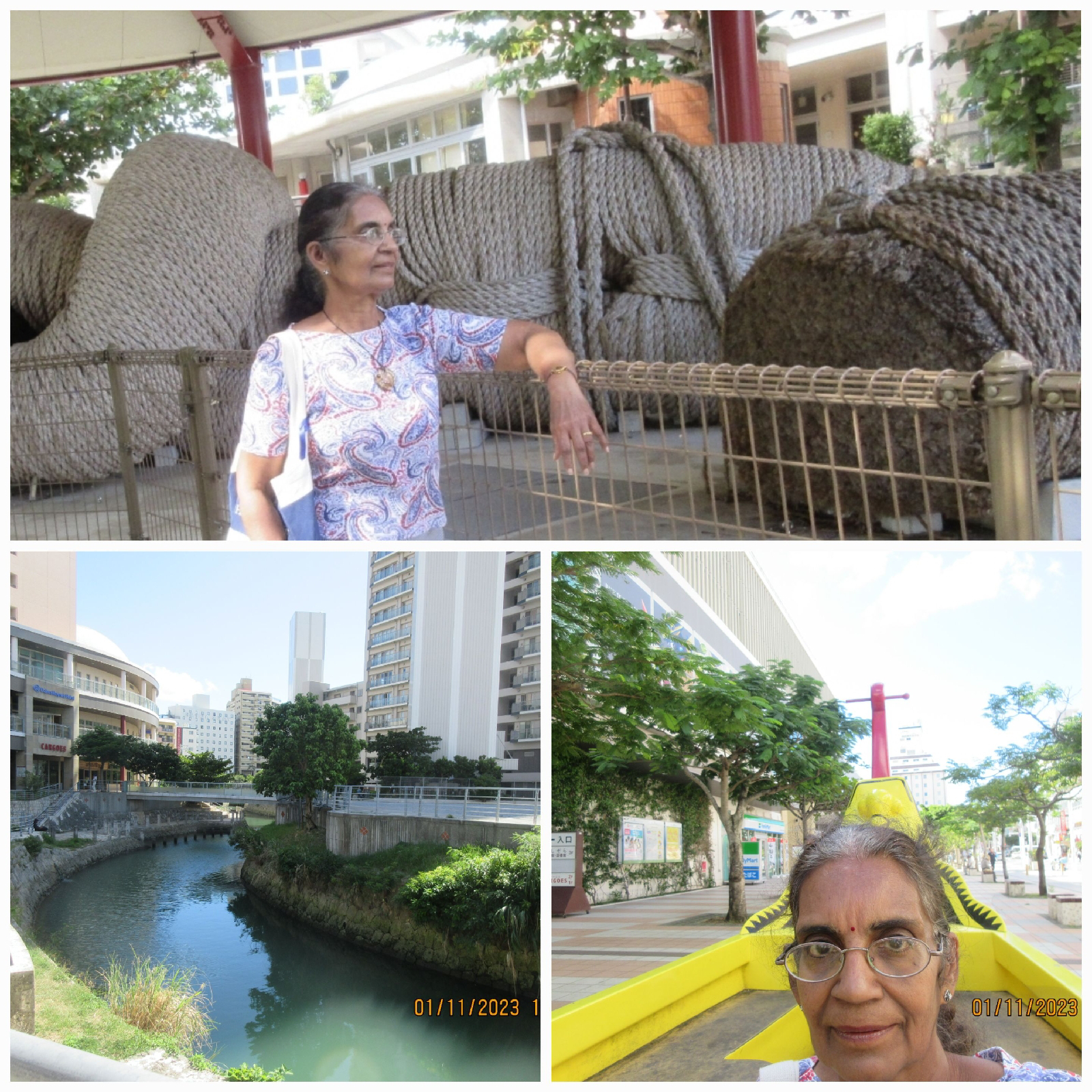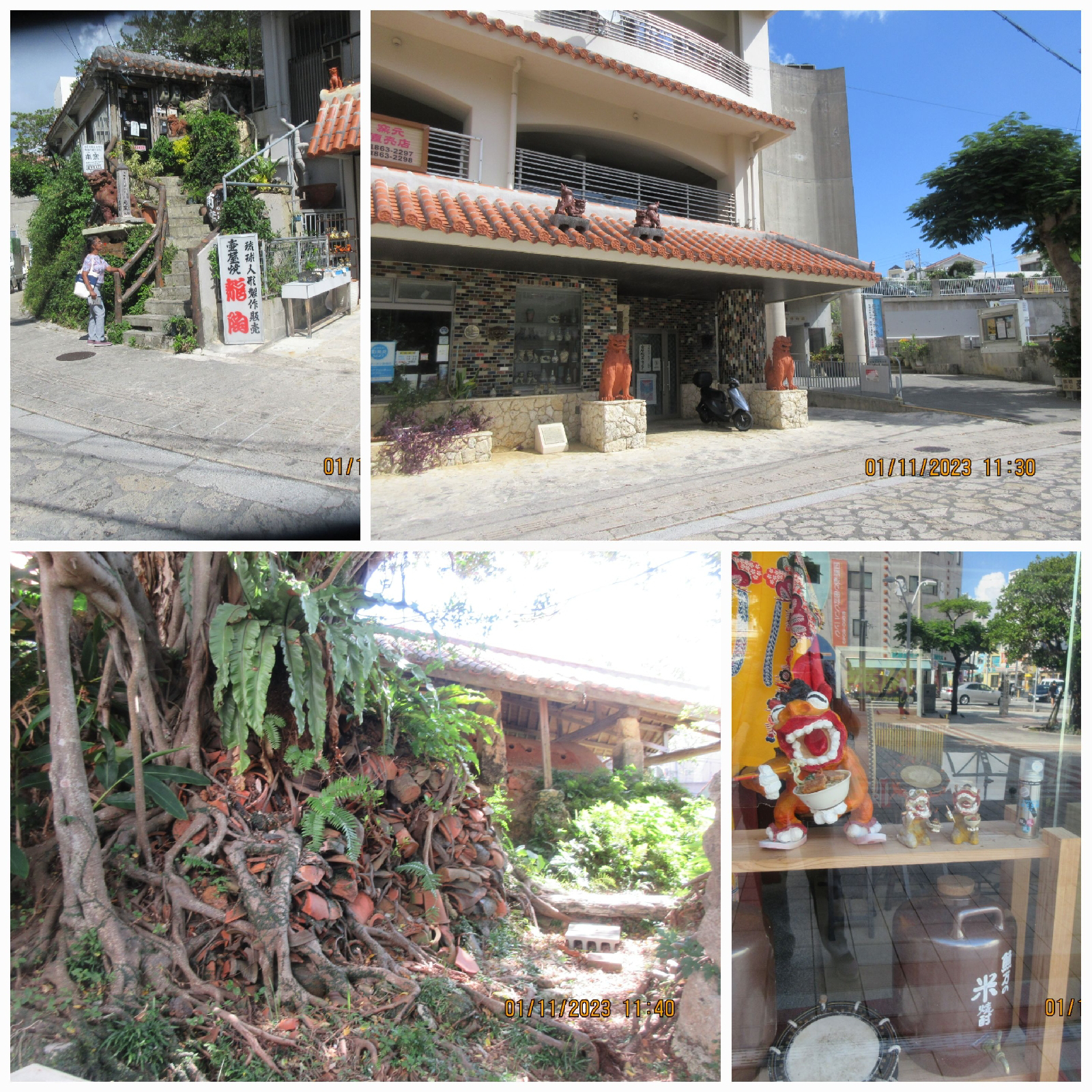Naha: Dragon or Mushroom?
Naha, a city in Okinawa, Japan. Most of us who are familiar with WW II will remember Okinawa as the island where the US Marines defeated the Imperial Japanese military in 1945
During my school days I remembered Naha by associating it with a Sanscrit homonym, Naga, which means dragon -- a mythical creature with slightly different features in various Asian folklore. My nemonics didn't go far wrong, or so I thought. As we enter the entirely rebuilt city from the cruise port we are greeted by two towering dragon like pillarss.No problem with the nemonic. But the origin of the name? I had something to learn. Naha is a Western Japanese name for mushroom! There had been a mushroom shaped rock in the city which has since gradually eroded to the ground and disappeared entirely. The name remains. It seems an apt description for a town that was completely destroyed during the battle of Okinawa mushrooming into the vibrant city it is now.
It's all about location and worth
Where is the tourist information center? Opposite McDonalds and therefore easy to locate!
We are not sure we want to take the public transport to visit the restored and rebuilt Shujiro Castle touted to have beautiful gardens (as only Japanese gardens can be). They are free to enter but the castle itself is under renovation. The guide at the information centre looks up the entry fees and then helpfully adds that we would be charged only half the rate since there would be very little to see until the works are complete. If we did go we would still not be able to visit the 450 metre long complex of tunnels underneath it that were used as a major command post by the Imperial Japanese military during World War II, the reason why the castle was subsequently almost destroyed by the US Marines. Did we visit? . .
.
Traditions and associations
Our free shuttle from the port drops us off, as usual, at the popular shopping arcade with a warren of side streets an alleys. Flanking the entrance of the arcade are two shisaas, lion dog statues,l one with a closed mouth and the other open as though baring its teeth. These are no laughing matter.. The close-mouthed keeps the good spirits protected within while the open mouthed frightens (roars?) evil spirits away. They are talismans that form a significant part of the Okinawan culture. You see them everywhere, at entrances to buildings, on roofs, at the corners of eaves, and of course, in abundance at the temples and shrines.
You may wonder: Isn't the lion a Chinese symbol? Yes, it is. But why in Japan? That, of course, takes you back to ancient history and how the island was once part of China. I am told some Okinawans also speak Hokkien, a Chines dialect.
Chanpuri, paanipuri, potpourri
Okinawa boasts of 'Chanpuri' cuisine. The word reminds me of the Indian 'paanipuri' ( crispy bite sized shell loaded with spicy salad). In fact, The Japanese word 'Chanpuri' means 'that which is mixed'!
How so? Japanese penchants, Hawaiian weather, flavours of China, American symbols!
Are we in Hawaii?
It is a blazing sunny day. We find ourselves taking shelter in the shadows of lamp-posts as we wait for the lights to change at the crossroads of Kokusai-dōri, the main shopping thoroughfare. We weave through explosions of colour. The alleys are interesting and crowded but we have seen enough. Okinawa is the Hawaii of Japan. Palm trees line the streets. Eye-catching, colourfully printed Hawaiian like beach attire and footware seem to tumble out of the little shops.
Dog fashion
The same shops also sell beach wear for dogs in displays that would certainly tempt the dog owner. I can't speak for the dogs.
American symbols
We have enough of the nearly 2 km long shopping street filled with groups of Japanese youth dressed in different uniforms, carrying large shopping bags that display 'Spam', 'Orion', etc. Go figure the large presence of 'America'!
Cuisine
Time to make the quick customary fish market visit,which turns out to be rather quiet for it's rather late in the day. The restaurants here serve more meat, not just sea food, and a greater variety of vegetables and fruits compared to the rest of Japan. This also is a result of history and geography (the tropical climate).
Dragon boat
Farther along the road, outside a swanky glass and steel building -- along a meandering canal that has concrete paths lining both banks, crisscrossed by bridges-- occupied by high end shops which do not seem as popular with the youth as the shopping street, sits a huge yellow boat which I almost miss in spite of its size and bright yellow paint. It was sitting just a few metres ahead of me and yet I had to find someone to show me where it was. Expectations and reality to not always match. Alas , it was only a replica of a simplified dragon boat reminiscent of the boat races of the past. Another mark of Chinese influence. With one side cut off and pairs of concrete seats down the middle you could sit there and imagine yourself in a race.
Kid-me-(k)not
Next we find a relatively shady road that takes us towards a pottery lane. We are distracted by a display of what seems like a gigantic rope knot. It is a rope! It is huge. Not even Sumo wrestlers but only giants, or machines can even pick it up.The cross section is fascinating. We find a board that tells us about it in English. A rope used in a tug-of-war. It was pulled using thinner ropes placed strategically along the thicker one. Needless to say the rope was used to celebrate either a coronation or a victory.
Pottery: slipped in or painted on?
As we walk we see unmistakable signs of the pottery lane. Shops line the slightly undulating and meandering street. Some are ancient. These were the only ones that remained almost intact during the battle of Okinawa. We could have walked into any of these and not be surprised to see a potter at his wheel creating beautiful ceramics. One fairy-tale-like cottage, perched on a low hill, looked particularly ancient and promising but too intimidating because of the awe it inspired. Climbing up the hill from the back I came across a long traditional adobe kiln. Going by the shards of pottery laid at the base of the trees with ancient gnarled roots holding them in place certainly did evoke a strong sense admiration and respect for the artists devoted to their work now displayed in museums. Their work was unlike the Chinese Ming ceramics with fine, intricate paintings. The Okinawan pottery, the way I see it, were shapes that were determined by the natural earth colours blended or slipped into them as they were shaped.
Religion
It is extremely hot today compared to the last few months. Getting a tan! So we return to the ship and then get back onto the pier as the day gets cooler thanks to a few clouds. Throughout our walk in the morning we have come across several shrines that ranged in size from a tiny hut to a multi-roomed building with tiled roofs. We have spotted one near the pier. We cross the major junction flanked by the dragons to get to the teeny weeny stretch of a beach. We find ourselves at the foot of a hill on which stands a place of worship with its unmistakable tile roofs with sishas placed at various points. We work our way around the hill and find the path that takes us up to a flight of stairs through a couple of Shinto arches. The temple next to it is locked. Spying through the glass sliding doors we can feel the sublimity and calmness of the white pebble covered zen courtyard. The buildings around it seem to embody structures related to, Buddhism, and Taoism. Again the unmistakable Chinese heritage.
Threats
Happy that we found a calm end to our day we leave the old Confucius temple. The moment we do the skies open. We break into a quick walk hoping the rain will peter out. As we walk down a couple of punk( because of their hairstyle) like youth loudly ask us where we are from. This is Japan and so we give them our unguarded honest answer even though their bold manner didn't reflect the Japanese respect. We try to find shelter under the trees but we have no idea if the rain will stop and so we continue. We get a little drenched. The ground emanates its earthly smell. As we were rush to the ship the drops peter out. We are dry by the time we reach the ship. We made it. We will leave the port in an hour.
The incident with the bold Japanese youth keeps bothering me. Why? They remind me of the Yakuza. Wasn't one of the culprits of the Sarin attack in Tokyo arrested on the island of Okinawa?
Fukusyen Park
This Chinese garden is close to the pier. Pictures do not do justice to the aesthetic lauot, choice of structures and that of the plants.
Did you know?
Karate originated in Okinawa. It evolved from the ancient Kung Fu
Residents of Naha have the worlds longest life span.















No comments:
Post a Comment
Comments are welcome